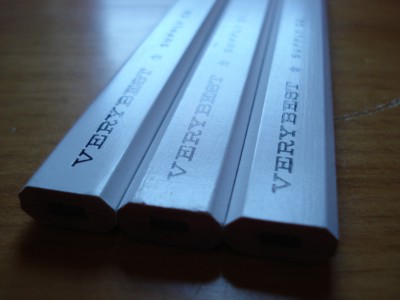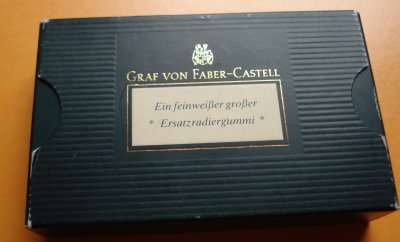
There are erasers, and then there are erasers. Once again, the Graf von Faber-Castell line exceeds expectations. An elegant white vinyl eraser with ribbing that matches their pencil line (and sharpeners), the eraser looks good as is. With a silver-plate cover, it becomes a must have object for pencil lovers.
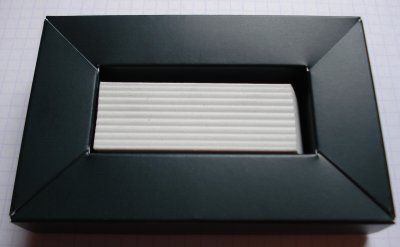
The eraser is in the typical shape – a three dimensional parallelogram. (Those with recollections of high school geometry can assist me if there is a more precise name.) The ribbing is lengthwise, and it’s a nice weight for such an object. With the cover (which looks engravable), it becomes even nicer.
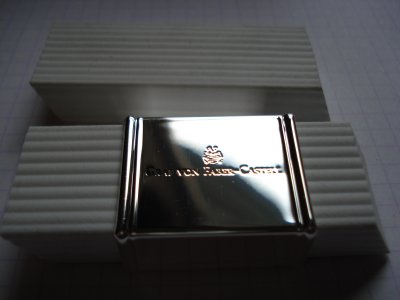
I’ve been using some soft lead vintage pencils this weekend, and this eraser removes even very dark lines with aplomb. The residue is unusually fine, which may not be ideal depending on the circumstance in which it is used.
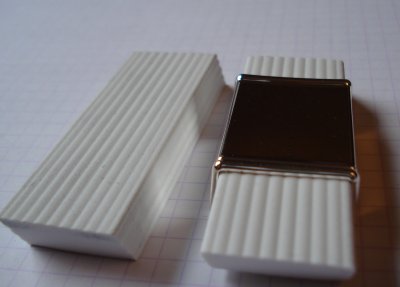
Overall, it’s a functional, creative and elegant rendition of a stationery staple.
Prismacolor Turquoise Pencil
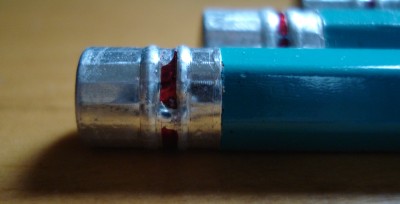
Here’s a modern pencil with a unique retro look and quite a bit of history. The Eagle Turquoise dates from at least 1901 (according to the Berol UK website) and is mentioned in Petroski’s The Pencil. It was made by Eagle (which became Berol), and eventually acquired by Sanford.
The pencil is turquoise (did I have to state that?) with silver stamping, and has a noticeable metal cap. It’s not a common feature. The cap has a faint red stripe.
It is imprinted:
USA ‘Chemi-Sealed’ Prismacolor Turquoise 02263 (375) 2B
The five digit number varies with the pencil grade.
It’s a good pencil, and does indeed seem quite strong. It writes smoothly and darkly without the graphite crumbling – no complaints.
The box (a typical art supply tin) has this description:
“The long-standing tradition of Turquoise professional drawing pencils continues to set the industry standard for the highest quality in technical and fine art drawing. Pure and smooth laydown in a wide variety of grades, the lead sharpens to a perfect point for a scartchless, glossy line in any weight.”
The “Prismacolor” branding is much more emphasized than the “Turquoise” name.
I happen to have a couple of older boxes of Turquoise pencils from the Berol and Eagle eras, shown below.
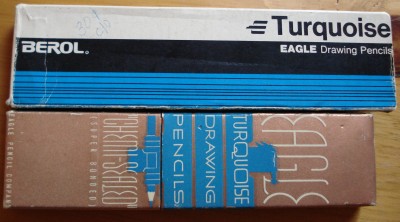
The newer box says, “Turquiose Eagle Drawing Pencils with strong, smooth durable leads precision graded in 17 degrees.”
The older box is more verbose:
“Stronger points…Developed by seven years of intensive research, the super-bonding process (U.S. Patent Nos. 1,854,905 and 1,892,508) welds the Turquoise lead and wood into a solid unit that effectively resists point breakage.
“Exact grading…Scientific proportioning of graphite and clay in 17 different lead formulas akes every Turquoise true-to-grade. The super bonding process prevents any change in this basic perfection and guarantees lasting uniformity.
“Smoother leads..The correct content of rare lubricating waxes is permanently retained in the leads by the impervious coating deposited on them in the super bonding process.”
Wow! Would it be possible to market a pencil in this manner today? I love all the references to science and research.
The older pencils actually have the patent numbers printed on the pencils!
The Turquoise is a winner – a reasonably priced high quality modern pencil, with some design flair and a century of history. What’s not to like?
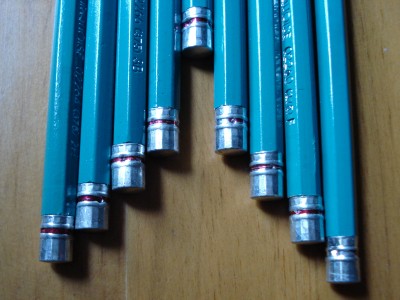
Faber-Castell Jumbo Grip Pencil
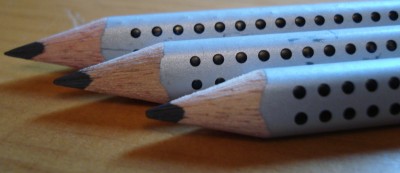
Following the immense success of the fantastic Grip 2001 pencil, Faber-Castell extended the line with erasers, sharpeners, colour pencils, mechanical pencils, and this, an oversize pencil.
Marketed as being easy to grip, and useful for children learning to write, both the pencil and the lead core of the Jumbo grip are oversize. Unlike the Grip 2001, the cap is unfinished, and the pencil has a reserved place to write one’s name. While the colour scheme is the same as the 2001, the dots are raised much less, the paint seems much thinner, and is more matte than glossy.
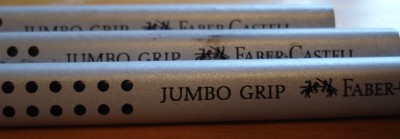
I found it a little bit awkward to use. It may just be that I’m not generally using oversize triangular pencils.
It’s also noticeably not the calibre of finish that the original Grip has. This is quite disappointing, as these are sold at a high price point.
The lead is visibly different (lighter) than that of the original, and perhaps a tad less smooth.
Overall, it seems like Faber-Castell made a derivative knock-off of their own high end product.
Bruynzeel High Grade 1605 Pencil

It’s always great to find a new pencil brand. Though I had heard the name long ago, it was quite a while before I found some pencils made by Bruynzeel in the Netherlands.
They came in a tin of the sort that’s found at art supply stores, with a range of pencil grades. There are eleven grades from 4H to 6B, with two of the HB included. The tin itself is generic, with a sticker as the only marking.
The pencils are a bright yellow, with stamping in gold or black. I couldn’t see a pattern in the stamping colour choice. The two HB pencils came with one in black, and one in gold. The hard pencils have blue caps, the soft pencils red, and HB in the middle gets black. Overall, the presentation and appearance of the pencils is sub-par. They also suffer from the adherence of graphite dust to the pencil. Having chosen a bright yellow finish, the dust stands out quite a bit.
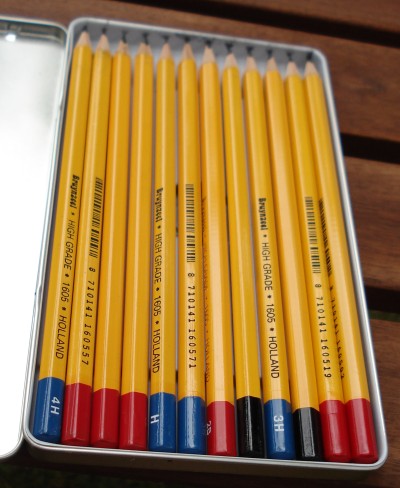
Trying them out, it doesn’t take too long to make a judgement – they are scratchy, scratchy, scratchy! A Sanford Mirado is more pleasant to write with. Even the 2B and 3B are markedly less smooth than almost any quality pencil one would want to use.
Unfortunately, this 1605 isn’t a pencil I can recommend.
Faber-Castell Aluminum Perfect Pencil line extended with black + silver pencils.

Faber-Castell has introduced a silver and black extension to their Aluminum Perfect Pencil.
The Perfect Pencil line is a series of pencil extenders that serve as stylish point protectors, and feature clips and built-in sharpeners. Higher end models in sterling silver, stainless steel, and white gold rank with fine fountain pens as luxury writing implements. The Aluminum variant is above the low-end plastic version, and below the precious metal versions in the lineup.
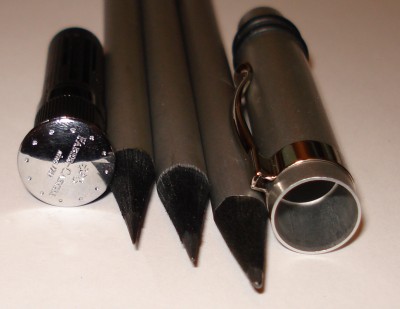
The new pencil is in a sleek silver paint with black dyed wood, black ferrule, and black eraser. This perfectly matches the aluminum of the cap. It is a very nice looking pencil, on par with the Design pencil or offerings from Nava. It gets noticed, while also being a first rate pencil.
International Arrivals Carpenter Pencils
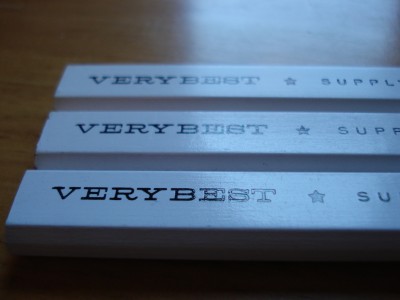
This is the second mention of products from International Arrivals on this site. These Taiwanese made carpenter pencils are striking in their retail environs – are there carpenters who shop at designer knick-knack shops? Probably – but not while looking for carpentry supplies. They are a bright varnished (and impractical) white.
They’re great if you love pencils. How do they work? I didn’t bother sharpening them. I assumed that wasn’t their purpose.
